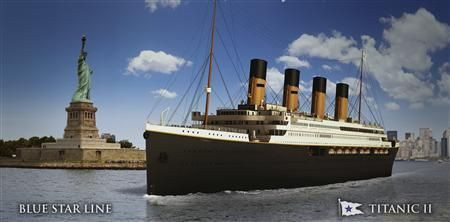Titanic II Should Be Safer, Thanks To Modern Engineering

An Australian billionaire plans to build a replica of the RMS Titanic and launch it in 2016, 104 years after the original met a tragic end on her maiden voyage. Given what we know about the Titanic’s design flaws, can modern technology copy the ship while making it safer?
In a word, yes. Even the steel used to make Titanic II will be stronger, thanks to modern metallurgy.
It’s likely that the metal the Titanic’s shipbuilders in Belfast had to work with was a big factor in the ship’s doom. In the 1990s the late Phil Leighly, a professor of metallurgical engineering Missouri University of Science and Technology, analyzed more than 400 pounds of steel from the Titanic’s hull. He found that the metal was not nearly as impact-resistant as modern steel, thanks to how it was made.
Back in the early 1900s, British steel manufacturers worked with open-hearth furnaces that turned out “semi-killed” steel, which has higher concentrations of phosphorus, oxygen and sulfur. Those elements make semi-killed steel more brittle at low temperatures than modern steel, which tends to have high concentrations of manganese to strengthen it, and minimal concentrations of phosphorus and sulfur.
"It was bad steel; there's no question," Leighly said of the original Titanic's composition, "but probably the best plain carbon ship plate available at the time.”
Leighly’s finding is reinforced by reports from survivors of the disaster saying they’d heard loud cracking noises as the Titanic sank – cracking, rather than groaning sounds, is indicative that the steel is brittle. Steel made brittle by the North Atlantic’s frigid waters may have made it easier for the iceberg to rip a long gash in the Titanic’s side, but many other factors contributed to the sinking.
The watertight compartments that supposedly made the Titanic "unsinkable" were not, in fact, completely closed off. The tops of the compartments were open, and their walls extended just a few feet above the waterline. This meant that even after the compartments were sealed once the ship was struck, the water could spill into adjacent compartments as the ship began to pitch forward.
In fact, some researchers have concluded that the watertight compartments may have actually sealed the Titanic’s fate by keeping water in the ship’s bow. Without the compartments, the Titanic would have flooded more evenly and stayed afloat for possibly another six hours – enough time for nearby ships to rescue all of the people aboard.
“It's easy to point a finger and say, 'Bad steel.' But it's uncomfortable to point at yourself and say, 'Bad design,'" Leighly said.
While the copy is being designed to mimic the Titanic, Titanic II’s design contains a number of features aimed at correcting some of the flaws in the original. Titanic II will be a few meters wider than Titanic, to provide additional stability, and have additional escape staircases and, most importantly, a full complement of lifeboats. The original Titanic disaster was worsened by the fact that the ship carried only enough lifeboats to house about half of the people onboard.
Titanic II will also have a modern engine and navigation equipment that can scrutinize reports from other ships, satellite images, and radar feedback to spot any threatening icebergs. But with an Arctic that’s seen record ice losses thanks to climate change, Titanic II will likely have less icebergs to worry about than its doomed sister ship.
However, the ship's patron, Clive Palmer, abstained from declaring that the Titanic II was unsinkable, as the Titanic's makers did.
"Anything will sink if you put a hole in it," Palmer said on Tuesday, according to Reuters. "I think it would be very cavalier to say it."
© Copyright IBTimes 2025. All rights reserved.





















